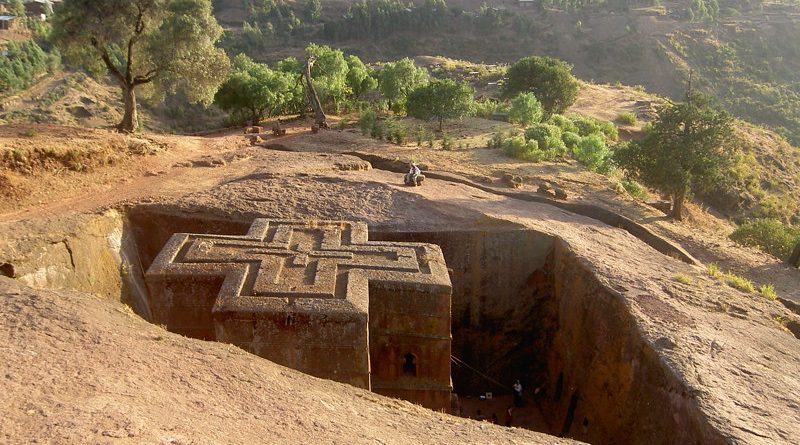The Labyrinth Stone Churches of Lalibela
History Facts
Where: Lalibelia, North Ethiopia, East Africa
When: 12th Century AD
History: Dug out churches in the rock bed, cliffs and mountains interconnected with tunnels. Inspired by angels. Home of the precious Coptic Cross
Ancient history
Eleven sacred stone monuments to the Christian God have been standing in Northern Ethiopia since the 12th century when they were cut from the earth under the auspices of King Lalibela(1181-1221).
The local legend claims that Lalibela’s brother Harbay could not contain his jealousy of his mother, Queen Roha’s, other son. “Lalibela” means “the bee that recognizes sovereignty”; the Queen named her baby after seeing a swarm of bees around him, in the belief that animals reveal divine auguries. Harbay poisoned Lalibela which sent him into a three day “death” during which he visited the first, second, and third heaven, receiving instructions from God that he must return to Roha. God also slipped him the architectural design plans for the magnificent churches that still stand in the town of Lalibela today, carved from red volcanic rock.
Another more plausible explanation for the rock hewn homage is that Lalibela visited Jerusalemand returned to Ethiopia with the idea of creating a new holy city. The churches are carved out of the rock bed, cliff face, and mountainside, interconnecting through numerous underground passages. A river, aptly named the Jordan and also serving as a symbol of Christ’s baptism, divides the churches into two groups. On one side of the river the churches of earthly Jerusalem reside, and the other is the mystical land of heavenly Jerusalem.
Recent holy invasions
The legend says that this sacred complex was completed in either 24 years, or 24 hours with the help of angels who worked at night. In all probability it must have taken hundreds of years to create such an immense series of interconnecting structures, but those who still patronise the churches of Lalibela for holy ceremonies are those who truly create the city’s hallowed character.
Beta Medahne Alem, in the shape of a Greek cross, measures 100 ft long, 75 ft wide and 35ft high. The roof is aligned on ground level and is covered to prevent erosion. Inside rests the Afro Ayigeba, a 2ft long ornately decorated cross. This Coptic Cross, ascribed with healing powers, is constantly guarded by a minimum of two men. In 1997 a priest waited until one guard had gone to relieve himself and the remaining one was asleep. Then he snuck in and stole the ancient cross to bring it to the bedside of an ailing young girl. Her father plied the priest with liquor and in the morning the priest awoke outside without the cross. The father and brother of the girl claimed to have buried it in the back yard, but it was actually sold it for 1,000 birr ($115 U.S. dollars) to an antique dealer in the nearby town of Desi, who sold it on to an antique dealer in Addis Ababa, who then sold the priceless Ethiopian treasure to a Belgian collector for 25,000 U.S. dollars. It was returned in 2001 to its sacramental location in Lalibela where it continues to attract pilgrims from remote hamlets all across the country.
Carved out architecture
Four of these churches are completely free standing: These are Beta Medhane Alem (the House of the Saviour of the World), Beta Maryam (the House of Mary), Beta Amanuel (the House of Emanuel) and Beta Ghiorghis (the House of St George). A courtyard is dug around their walls and only the smooth floor, worn from years of devout pilgrims walking in to prostrate themselves, touches the ground.
Bet Maryam contains a square pool in which childless women dip themselves and pray to conceive. Beta Golgotha, the House of Golgotha, stands behind a large, hollow, rectangular block of stone, the Tomb of Adam. Beta Ammanuel, the house of Emmanuel, is reached through a tunnel opening into a courtyard where the delicately carved structure is situated. Beta Abba Libanos was built by Maskal, King Lalibela’s Queen in his memoriam; all four of its walls stand free, but it is further attached to the earth by the roof that melts into the towering cliff.
What to see and do
The most popular services are at dawn, before the day’s heat and fieldwork for the residents. Inside the twisting tunnels lined with Christian relics and humble pilgrims, the sounds of the service echoes off the stone. Drums, tambourines, and chants intended to lift the soul high above this earth and life, echo deep within the hardened stone earth moulded by human hands.
The most exciting time to visit Lalibela is during one of the many colourful religious festivals that bring out the town and the priests in full costumes of gold lamé, purple, red, and blue. Timkat, the celebration of the Epiphany (the baptism of Christ), is celebrated by carrying a replica of theArk of the Covenant through town in a grand procession.
Getting there
Ethiopian Airlines operates relatively cheap daily flights to Lalibela from Addis Ababa, for around US$100 one way. This is by far the most comfortable way to travel. Flights can be booked in advance through any of the Ethiopian Airlines offices in Addis Ababa or worldwide.
From the airport at Kombolcha you can take a bus into Lalibela. Alternatively you can travel the whole way from Addis Ababa to Lalibela by bus for about US$3, but it’s a bumpy, ten-hour journey.
Where to stay
There are hotels in Lalibela to suit all budgets. Top end hotels such as the Lal Hotel (Tel: +251 3 360008) are comfortable but expensive. There are a number of reasonable government-run hotels such as Hotel Roha Lalibela (+251 3 360009), which are of a reasonable standard, but still pricey compared with the budget options. The Asheton Hotel (+251 3 360030) is basic but clean and very popular with travellers. Rooms at the Asheton cost between US$4 and US$8 a night depending on the facilities. Note that there are no street names in Ethiopia. If you call in advance the hotel will be able to give you directions.
Other expenses
You can eat very cheaply if you opt for local restaurants where you can get a good, substantial meal for under US$6. At the hotels, you will pay significantly more, but it is still quite reasonable. Lalibela is famous for its honey wine, known locally as tej, so make sure you try some while you¹re in town.
Entrance to the churches costs US$2.50 or you can buy a general ticket for US$12, which allows you to enter all the churches in town as often as you like.
Once you’re there
Amharic is the most widely spoken language in Ethiopia, especially in the highlands. It’s a difficult language but it¹s worth learning a few words as not many people speak English. The other main languages are Tigrinya (spoken in Tigray and Eritrea) and Oromigna (spoken mainly in the south).
There are fleas in Lalibela, and although you shouldn’t suffer too much if you stay in one of the larger hotels, you are likely to encounter problems when visiting the churches. Sting relief spray or lotion is extremely useful.
More information:
Timkat in Lalibela
Definitive photos if the celebration




